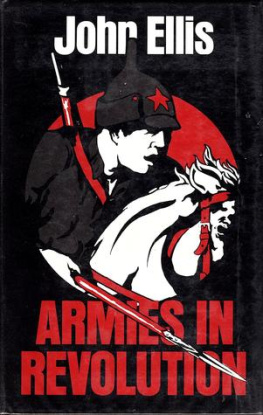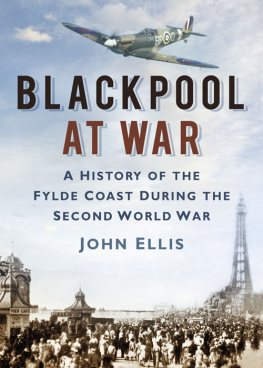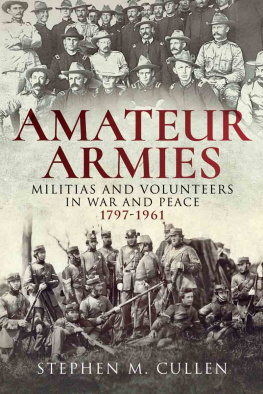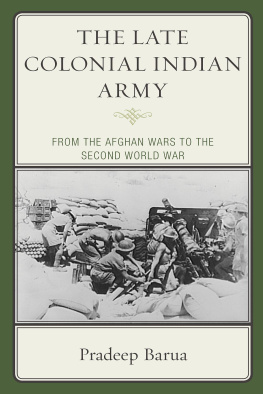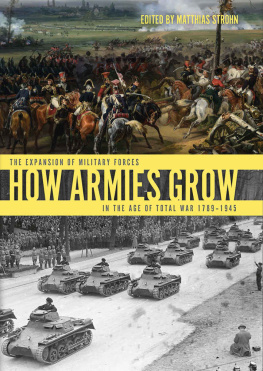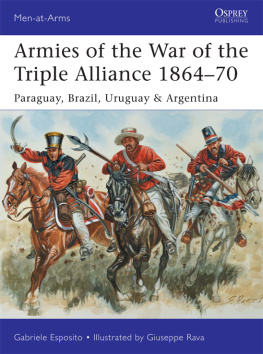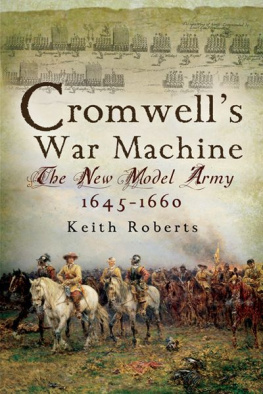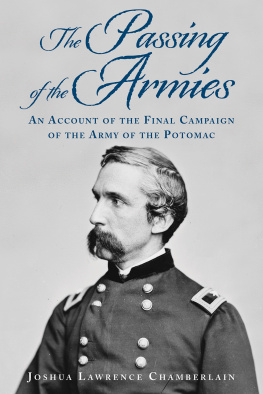REVOLUTION
Volume 1
ARMIES IN REVOLUTION
ARMIES IN REVOLUTION
JOHN ELLIS
First published in 1973 by Croom Helm Ltd
This edition first published in 2022
by Routledge
4 Park Square, Milton Park, Abingdon, Oxon OX14 4RN
and by Routledge
605 Third Avenue, New York, NY 10158
Routledge is an imprint of the Taylor & Francis Group, an informa business
1973 John Ellis
All rights reserved. No part of this book may be reprinted or reproduced or utilised in any form or by any electronic, mechanical, or other means, now known or hereafter invented, including photocopying and recording, or in any information storage or retrieval system, without permission in writing from the publishers.
Trademark notice: Product or corporate names may be trademarks or registered trademarks, and are used only for identification and explanation without intent to infringe.
British Library Cataloguing in Publication Data
A catalogue record for this book is available from the British Library
ISBN: 978-1-032-12623-4 (Set)
ISBN: 978-1-003-26095-0 (Set) (ebk)
ISBN: 978-1-032-16426-7 (Volume 1) (hbk)
ISBN: 978-1-032-16427-4 (Volume 1) (pbk)
ISBN: 978-1-003-24850-7 (Volume 1) (ebk)
DOI: 10.4324/9781003248507
Publishers Note
The publisher has gone to great lengths to ensure the quality of this reprint but points out that some imperfections in the original copies may be apparent.
Disclaimer
The publisher has made every effort to trace copyright holders and would welcome correspondence from those they have been unable to trace.
Armies in Revolution
JOHN ELLIS
FIRST PUBLISHED 1973
1973 BY JOHN ELLIS
CROOM HELM LTD
210 ST JOHNS ROAD, LONDON SW11
ISBN 0856640255
PRINTED AND BOUND IN GREAT BRITAIN
BY RICHARD CLAY (THE CHAUCER PRESS) LTD
BUNGAY SUFFOLK
Contents
2. The English Civil War 16429
3. The American War of Independence 177583
4. The French Revolution 178994
5. The Prussian Army Reforms 180615
6. The Franco-Prussian War and the Paris Commune 187071
7. The Russian Civil War 191720
8. The Chinese Civil War 192649
9. Conclusion
Acknowledgements
I am above all grateful to Mr Michael Elliott-Bateman and the Department of Military Studies at the University of Manchester for providing an environment in which to pursue this study. Thanks are also due to the Social Science Research Council for providing financial backing during the years 1969-71. Finally I should like to acknowledge the roles of Harry Gilbert whose rigorous criticisms were of the greatest assistance, and of my publisher David Croom whose suggestions have helped to ensure that the narrative retained some degree of fluency.
TO MY MOTHER
Chapter 1 Introduction
This is a study of revolutionary war. The chapters are about different revolutions but the book presents two problems common to them all: how military policy affected the development of a particular revolution and how the social roots of that revolution affected methods of war and military organisation.
Why, for example, should the Chinese Communists have adopted the guerrilla mode of warfare whilst the American colonists or the Bolsheviks in Russia devoted all their efforts to the creation of regular forces? What is the significance of the different social origins of various revolutionary armies: the bourgeois Parisian National Guard of 1789, the proletarian and petty-bourgeois Communard forces, or the rurally based Red Armies of the Russian and Chinese Revolutions? What is the role of a political party such as the Jacobins or the Bolsheviks in the creation of a revolutionary army? What degree of operational autonomy can be allowed to the command personnel of such armies and what is the importance of such agents of the central political authority as the Jacobin reprsentants-en-mission or the Russian and Chinese commissars? Is their central role of an ideological or an administrative nature and to what extent did the chaplains of the New Model Army perform an analogous function? Can an existing regular army be truly revolutionised as was attempted in Prussia or must it be created from scratch as in America and China? Or is the French attempt to amalgamate regulars and revolutionaries the most viable solution? In China the revolutionaries were fighting to seize power whilst in the France of the First Republic and Russia they were fighting to hold on to power. What is the significance of such a distinction for the organisation and tactics of the revolutionary army? And to what extent should the Communards have attempted to seize power in the country rather than trying to hold on to power in the city? How important is it that the armies organisation and modes of combat reflect the concrete cultural and political preoccupations of the rank-and-file? How far can revolutionary notions of liberty and equality be equated with the maintenance of adequate military discipline? Why in some cases, such as the English Civil War, does revolutionary zeal supplement military discipline whilst in others, the Commune for example, it seems quite inimical to it?
In answering such questions this book will arrive at a comprehensive, historically based definition of what constitutes revolutionary war. This historical perspective is of vital importance. Contrary to the impression given by certain writers and commentators revolutionary warfare does not begin and end with Mao Tse-tung, nor even with guerrilla warfare as a whole. Although, in certain respects, the Chinese Revolution will be put forward as a paradigm, it will be clear by the time that that chapter is reached that Mao was far from being the first to tackle these particular problems, and that others had sometimes solved them, perhaps in different ways, in earlier times. The Maoist political line was a particular response to a particular problem and not a totally innovatory aspect of military practice and theory. It is time that Mao Tse-tung was put in historical context. At present revolutionary warfare is increasingly regarded as a synonym for the Chinese-Vietnamese mode of guerrilla-mobile war. Revolutionaries and counterrevolutionaries alike are in danger of turning guidelines that were specific to a certain situation into dogmas and blindly trying to apply them to circumstances to which they are simply not appropriate. Certainly the Chinese Revolution was of immense significance and that is why it ends this book. But it must not be inferred that Mao is regarded as having said the last word on the subject. The fate of the Hukbalahaps in the Philippines, the Malayan Communists, the Indian guerrillas in Telingana, the Indonesian Communists, Guevara in Bolivia should at least teach us not to think in terms of a unitary third world in which the same set of tactics is always applicable. All revolutions are unique but whatever general rules can be discerned must come from a study of the widest range of historical experience.
As must be clear from the list of questions above this book is primarily concerned with the social and political factors that influence military affairs. Each chapter will concentrate upon the most important social and political factors of the revolution with which it deals in an attempt to show how the actual dynamic of mass revolutionary unrest, in the various situations, affected the military policies of the revolutionary groups. But it would be misleading to claim that these factors alone defined the options open to the revolutionaries. To a greater or lesser extent purely physical or material constraints also limited those options, and it would be best at this stage to clear these aside so as to gain a clearer picture of what actual areas of activity are affected by larger social and political considerations. The book as a whole is trying to take military studies beyond questions of mere technique and static models of the rules of war, but it would be foolish to overstate the case and deny that, in certain cases, geographical and material immutables are bound to influence the formulation of military policy.

